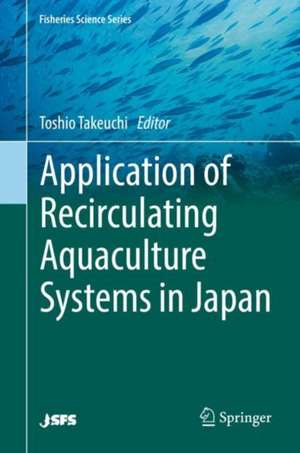Application of Recirculating Aquaculture Systems in Japan: Fisheries Science Series
Editat de Toshio Takeuchien Limba Engleză Hardback – 23 ian 2018
The book is a valuable resource for a wide readership, such as local government officers, energy-industry staff, maintenance and system engineers, as well as those from the construction, agriculture and fishery industries.
| Toate formatele și edițiile | Preț | Express |
|---|---|---|
| Paperback (1) | 1039.83 lei 38-44 zile | |
| Springer – 7 iun 2019 | 1039.83 lei 38-44 zile | |
| Hardback (1) | 1390.59 lei 3-5 săpt. | |
| Springer – 23 ian 2018 | 1390.59 lei 3-5 săpt. |
Preț: 1390.59 lei
Preț vechi: 1695.83 lei
-18% Nou
Puncte Express: 2086
Preț estimativ în valută:
266.09€ • 278.52$ • 221.47£
266.09€ • 278.52$ • 221.47£
Carte disponibilă
Livrare economică 10-24 martie
Preluare comenzi: 021 569.72.76
Specificații
ISBN-13: 9784431565833
ISBN-10: 4431565833
Pagini: 260
Ilustrații: XVII, 333 p. 193 illus., 88 illus. in color.
Dimensiuni: 155 x 235 mm
Greutate: 0.72 kg
Ediția:1st ed. 2017
Editura: Springer
Colecția Springer
Seria Fisheries Science Series
Locul publicării:Tokyo, Japan
ISBN-10: 4431565833
Pagini: 260
Ilustrații: XVII, 333 p. 193 illus., 88 illus. in color.
Dimensiuni: 155 x 235 mm
Greutate: 0.72 kg
Ediția:1st ed. 2017
Editura: Springer
Colecția Springer
Seria Fisheries Science Series
Locul publicării:Tokyo, Japan
Cuprins
Contributors.- Preface.- Part I. What is Recirculating Aquaculture Systems?.- Chapter 1 Overview of Land-based Recirculating Aquaculture.- Part II. Basic Information of Closed Recirculating Systems from the View point of Bioscience.- Chapter 2 Characteristics of Closed Recirculating Systems.- Part III. Tackle of Recirculating Aquaculture in Fishes.- Chapter 3 Eel Anguilla japonica—towards zero emission.- Chapter 4 Pejerrey Odonthestes bonariensis.- Chapter 5 Japanese Flounder Paralichthys olivaceus.- Chapter 6 Kuruma Shrimp Marsupenaeus japonicas.- Chapter 7 White Shrimp Litopenaeus vannamei.- Chapter 8Abalone Haliotis spp..- PartIV. Applications and Other Consideration for Recirculating Aquaculture Systems.- Chapter 9 Seed Production Systems.- Chapter 10 Aquarium Recirculating System.- Chapter 11 Aquaponics.- Chapter 12 Advantages of Environmentally Sound Poly-Eco-Aquaculture in Fish Farms.- Chapter 13 Closed Ecological Recirculating Aquaculture System.- Chapter 14 Consideration ofLand-based Facility for Closed Recirculating Aquaculture Using.- Index.
Recenzii
“This book will introduce you to the world of ”Recirculating Aquaculture Systems.” If your goal is to enjoy that world and to find detailed information on its technical and scientific aspects, you’ve found the right book. … The Japanese-made aquaculture system introduced in this book will invite you to consider the future of the system, and to promote aquaculture in your own country.” (Translated from Japanese, Dr. Masaharu Tokuda, Nippon Suisan Gakkaishi, Vol. 84 (3), 2018)
Notă biografică
Toshio Takeuchi, President
Tokyo University of Marine Science and Technology
Tokyo, Japan
Tokyo University of Marine Science and Technology
Tokyo, Japan
Textul de pe ultima copertă
This is the first English book to address the current development of closed recirculating aquaculture systems (cRASs) in Japan, and its implications for industry in the near future. It offers an introduction to the topic and discusses the industrial application of cRASs. Around Europe, cRASs using freshwater have been developed, but to date there is little information about cRASs using the saltwater. As such, the book introduces the technical development of cRASs using the saltwater in Japan and describes measures necessary for their industrialization. It also discusses in detail various species, e.g., flounder, pejerrey, kuruma shrimp, white shrimp and abalone, which have been raised in cRASs. Furthermore, it presents wide topics concerning the technological development of aquariums, an area in which progressive Japanese techniques dominate. Lastly, the book also examines CERAS and poly-culture in Japan.
The book is a valuable resource for a wide readership, such as local government officers, energy-industry staff, maintenance and system engineers, as well as those from the construction, agriculture and fishery industries.
The book is a valuable resource for a wide readership, such as local government officers, energy-industry staff, maintenance and system engineers, as well as those from the construction, agriculture and fishery industries.
Caracteristici
Offers information on state-of-art Japanese cRASs Covers a wide range of topics from basics to the application of cRASs Appeals to a wide readership thanks to its easy-to-understand descriptions



